DEFA was the state-owned film studio of the German Democratic Republic (GDR - East Germany). DEFA was an abbreviation for 'Deutsche Film AG' (German Film Corporation), reminiscent of the corporate name Ufa. It existed from 1946 to its liquidation in 1990 – nearly 45 years, longer than the GDR itself. The DEFA fostered a wide range of artistic developments. Alongside the ongoing production of light entertainment, it made films in the style of socialist realism, fairy tales and literary adaptations, staunchly antifascist films and Easterns (Indianerfilme) with a political subtext, as well as productions which took a critical view of contemporary social issues and provoked conflicts and bans.
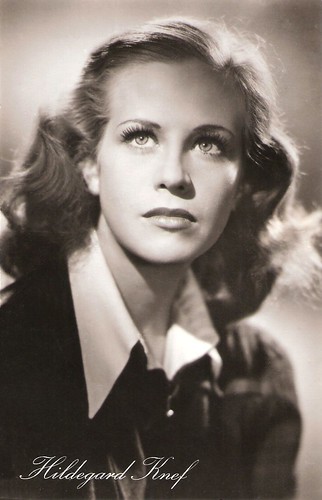
East-German postcard by VEB Progress Film-Vertrieb, Berlin, no. 7/319. 1957. Photo: DEFA.
Rebellious, gravel-voiced actress, chanteuse and author Hildegard Knef (1925-2002) was one of the most important film stars of post-war Germany. She had her breakthrough in the first film released after World War II in East Germany, Die Mörder sind unter uns/The Murderers Are Among Us (Wolfgang Staudte, 1946), produced by the DEFA. Her powerful performance as a Holocaust survivor amid the ruins of postwar Berlin made her immediately a star. Over 4 million East-Germans went to the cinema to see it.

German postcard by Starfoto Hasemann. Photo: DEFA. Publicity still for Freies Land/A Free Country (Milo Harbich, 1946).
Fritz Wagner (1915-1982) was a handsome German star in the European cinema of the 1940s and 1950s. From 1938 to 1976, he appeared in more than sixty films and TV productions. After the war, he played a leading role in the drama Freies Land/A Free Country (Milo Harbich, 1946) the second film of the newly founded DEFA studio in the Soviet occupation zone which later became East Germany. The propaganda film portrayed the effects of land reforms brought in by the Soviet authorities. It would be the only DEFA film until the mid-1950s that dealt with the hardships of East-Germany's rural life, and was heavily influenced by the Italian Neorealism of that time. Most people in the film weren't professional actors but farmers. The film proved to be very unsuccessful on its release. For the DEFA, he also played a leading role in the war drama Die Brücke/The Bridge (Arthur Pohl, 1949), and in Der Kahn der fröhlichen Leute/The boat of the happy people (Hans Heinrich, 1950) which sold more than 4,100,000 tickets.
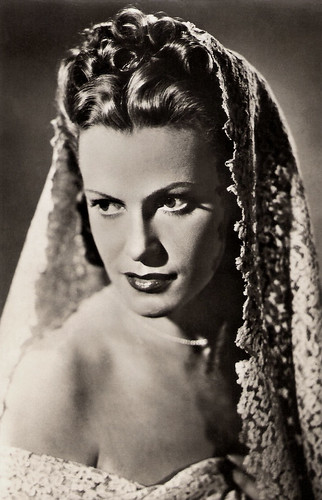
East-German postcard by VEB Progress Filmvertrieb, no. 620/64. Photo: DEFA / Neufeld. Publicity still for Figaros Hochzeit/The Marriage of Figaro (Georg Wildhagen, 1949).
Austrian Angelika Hauff (1922–1983) played the lead in several post-war German and Austrian films. For the DEFA, she appeared in three films, including the box office hit Figaros Hochzeit/The Marriage of Figaro (Georg Wildhagen, 1949) with Willy Domgraf-Fassbaender and Sabine Peters. It was based on the opera 'The Marriage of Figaro' by Wolfgang Amadeus Mozart and Lorenzo da Ponte, which was itself based on the play 'The Marriage of Figaro' by Pierre Beaumarchais. Hauff plays the chambermaid Susanna, around whom the men fight. The film was the first opera film made by DEFA and it was a huge success with 5,479,427 tickets sold.
The DEFA was officially founded on 17 May 17, 1946 in the former Althoff Studios in Potsdam-Babelsberg, part of the Soviet Occupied Zone in eastern Germany. It was the first film production company in post-war Germany. While the other Allies, in their zones of occupation, viewed a rapid revival of a German film industry with suspicion, the Soviets valued the medium as a primary means of re-educating the German populace as it emerged from twelve years of Nazi rule. The Soviet Military Administration (SMAD) handed over the license to 'Filmaktiv', a group of committed filmmakers and German Communist Party (KPD) members.
However, Wolfgang Staudte had already begun work on DEFA's first film, Die Mörder sind unter uns/The Murderers Are Among Us (1946) a few days days earlier. The first DEFA production was also Germany's very first post-war film. Staudte's film launched a long-term DEFA policy: in its style, content and ideology, it was a reaction against the propaganda films of Nazi Germany, a tactic which was to be especially successful in the DEFA's early classics. Stylistically, Die Mörder sind unter uns carried on the expressionist lighting tradition of the 1920s.
In Freies Land/Free Land (1946), Milo Harbich tried to synthesise stylistic elements of Soviet revolutionary film with didactic sermons on land reform. Kurt Maetzigs first feature film, Ehe im Schatten/Marriage in the Shadows (Kurt Maetzig, 1947), tells the story of married actors driven to suicide by the Nazis' anti-Semitic persecution, based on the fate of Joachim Gottschalk and his wife. The film was shown in all four occupation zones and drew more than ten million viewers in three years. Wolfgang Staudte's Rotation (1949) took a new approach to early 20th century German history by showing the lives of proletarian families, a contrast to the bourgeois perspective which had hitherto predominated.
The original board of directors consisted of Alfred Lindemann, Karl Hans Bergmann, and Herbert Volkmann, with Hans Klering as administrative Secretary. Klering, a former graphic designer, also designed DEFA's logo. On 13 August 1946, the company was officially registered as a joint-stock company (German: Aktiengesellschaft). By the end of the year, in addition to the Staudte film, it had completed two other feature films using the former Tobis studio facilities in Berlin and the Althoff Studios in Babelsberg. Subsequently, its principal studio was the Babelsberg Studio built by Ufa in the 1920s.
The DEFA was controlled by the Soviets. On 14 July 1947, the company officially moved its headquarters to the Babelsberg Studio, and on 13 November 1947, the company's 'stock' was taken over by the Socialist Unity Party or SED, which had originally capitalised DEFA, and pro-Soviet German individuals. Soviets Ilya Trauberg and Aleksandr Wolkenstein joined Lindemann, Bergmann and Volkmann on the board of directors, and a committee was established under the auspices of the Socialist Unity Party to review projects and screen rushes.
In July 1948, Lindemann was dismissed from the board of directors because of alleged 'financial irregularities' and replaced briefly by Walter Janka. In October 1948, the SED was instrumental in replacing Janka, Volkmann and Bergmann as corporate directors with official party members Wilhelm Meissner, Alexander Lösche and Grete Keilson. In December, the death of Trauberg and the resignation of Wolkenstein resulted in two more Soviets in their stead, Aleksandr Andriyevsky and Leonid Antonov.
In 1948, the division of Germany into zones controlled by the Soviet Union and by the Western Allies came into effect. The SED eventually became openly Communist, with a strong Stalinist orientation. On 23 May 1949, the Allies' Germany officially became the Federal Republic of Germany (commonly known as West Germany), and on 7 October 1949, the Soviet zone officially became the German Democratic Republic (East Germany). All DEFA interests were incorporated into the new nation as its 'people's' film monopoly according to the strictures of Stalinist Communism and socialist realism, and effectively an arm of the government.
In 1949 director Kurt Maetzig and the writer Friedrich Wolf exposed the close connections between the Nazis and the giant chemical company IG Farben in the film Der Rat der Götter/The Council of the Gods (Kurt Maetzig, 1950). Wolfgang Staudte's Der Untertan/Man of Straw (1951) was a scathing satire of German philistinism based on the novel by Heinrich Mann. The film was banned in West Germany for years.
This era at the DEFA came to a close around 1950, when the cultured, more liberal Soviet film officers and inspectors left the country after the founding of the GDR. The DEFA was taken over by German Stalinists like hardliner Sepp Schwab, who was appointed director-general of DEFA on 23 June 1950.
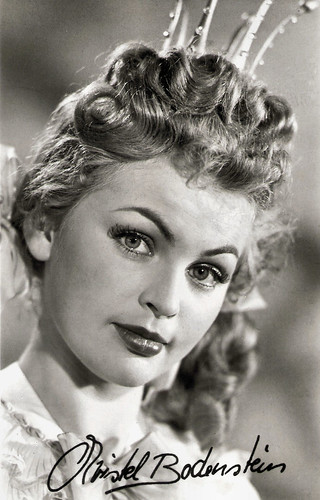
East-German postcard by VEB Progress Film-Vertrieb, no. no. 4213/447, 1957. Photo: DEFA / Wunsch. Publicity still for Das singende, klingende Bäumchen/The Singing Ringing Tree (Francesco Stefani, 1957).
Christel Bodenstein (1938) appeared in many DEFA productions and is best known for her leading role as princess in the fairytale film Das singende, klingende Bäumchen/The Singing Ringing Tree (Francesco Stefani, 1957). The story, written by Anne Geelhaar, was based on a variation of 'Hurleburlebutz' by the Brothers Grimm. Bodenstein played a beautiful but selfish and haughty princess who rejects the proposal of a wealthy prince (Eckart Dux). After its release in East Germany, the film sold almost 6 million tickets in the country of about 17 million.
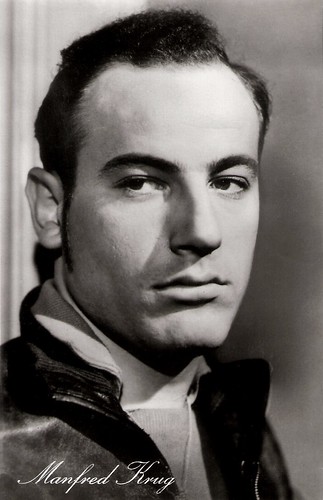
East-German postcard by VEB Progress Filmvertrieb, no. 966, 1959. Retail price: 0,20 DM. Photo: DEFA / Dassdorf. Publicity still for Reportage 57 (János Veiczi, 1959).
German actor Manfred Krug (1937) was often cast as a socialist hero in DEFA films of the former GDR. He also became known in East-Germany as a jazz singer. In 1977, he returned to West-Germany, where he became a popular TV star.
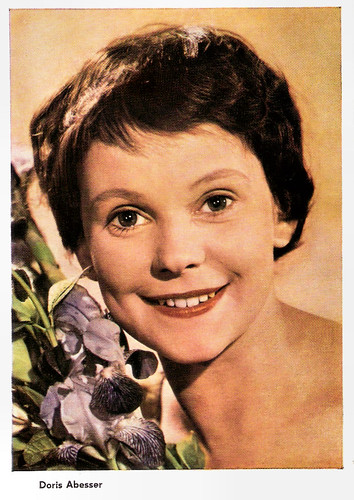
East-German postcard by VEB Progress Filmvertrieb, Berlin, no. 1329 F, 1960. Photo: Kurt Wunsch.
Doris Abesser (1935–2016) appeared since 1956 in several films by the DEFA and became one of the studio’s most popular stars. She worked with important directors like Frank Beyer, Heiner Carow and Kurt Maetzig. After the film Der Frühling braucht Zeit/Spring Takes Time (Günter Stahnke, 1965) was banned, the promising film career of the fresh and girly actress stalled.
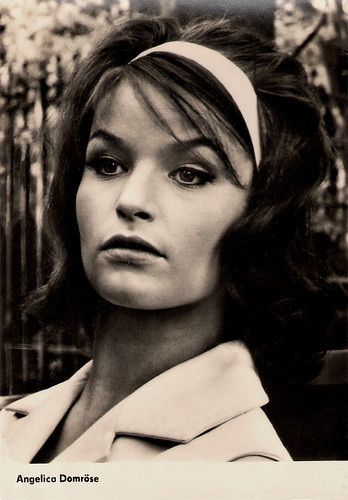
East-German postcard by VEB Progress Film-Vertrieb, Berlin, no. 1649, 1961. Retail price: 0,20 DM. Photo: Schütt / DEFA.
Angelica Domröse (1941) was one of the most famous film and stage actresses of former East Germany. She became a superstar through her role as the young mother Paula in the cult classic Die Legende von Paul und Paula/The Legend of Paul and Paula (Heiner Carow, 1973).
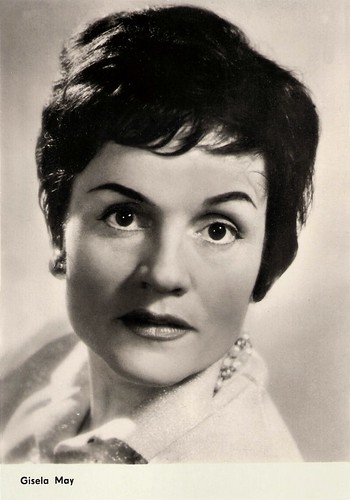
East-German postcard by VEB Progress Filmvertrieb, Berlin, no. 1684, 1962. Photo: Georg Meyer-Hanno.
Gisela May (1924-2016) was the first lady of the political song and a German national treasure. She was famous for her work at Bertolt Brecht's theatre group, the Berliner Ensemble. She was a diseuse (singing actress) in the tradition established by Lotte Lenya and Marlene Dietrich, and expert interpreter of the work of Brecht, Kurt Weill, Hanns Eisler, Kurt Tucholsky, and Jacques Brel. She also appeared in several DEFA productions and a few international films.
Hans Michael Bock at Filmportal.de: "The DEFA was based on the kind of traditional studio structure used in the Ufa and in Hollywood of the 1930s, but with one crucial difference: in Hollywood and even in Nazi Germany a number of production companies existed in competition, while in the GDR there was only one, and it was controlled by state and party functionaries, with the Hauptverwaltung Film playing the crucial role from 1954 onward. The official policy was to hire no directors or screenwriters tainted by association with National Socialist propaganda films. However, those who had worked in a 'merely' technical capacity during that period were welcome."
In the tradition of all major studios, the DEFA Studios in Potsdam-Babelsberg (the former 'Ufa city') had professionals in nearly all branches of the film industry on its payroll: screenwriters, directors, scenographers, cameramen, technicians and even an ensemble of actors. The result was a high level of technical expertise, especially in the field of set design, where the old German tradition of masters and apprentices continued to flourish.
On the other hand, artistic freedom and risk-taking was limited. As Soviet-Communist-Stalinist influences took hold at DEFA, the definition of desirable and acceptable themes for films became narrower. In June 1947, a film writer's conference held in Potsdam produced general agreement that the 'new' German cinema would disavow both subjects and stylistic elements reminiscent of those seen on German screens during, and prior to, the Nazi era. By 1949, expectations for scripts were codified around a small number of topics, such as '[re-]distribution of land' or 'the two-year plan'. As in the Soviet Union, the excessive control placed by the state on authors of screenplays, as against other literary works, discouraged many competent writers from contributing to East German film.
In 1951, Das Beil von Wandsbek/The Axe of Wandsbek (Falk Harnack, 1951), based on Arnold Zweig's novel written in exile, was banned . The DEFA production was not released until 1962, heavily edited. Erwin Geschonneck's nuanced portrayal of a butcher who becomes a Nazi executioner was out of step with the official policy of depicting moral issues in black and white. With the ban on Das Beil von Wandsbek, a brief five-year period which had produced several classics of German cinema drew to a close.
Screenwriters could find their efforts rejected for ideological reasons at any stage in script development, if not from the outset. The Cold War only made the Communist leaders tighten their grip on 'their' films. The DEFA's production reached an absolute statistical nadir in 1952 and 1953, with only five films produced in each year. As a result, between 1948 and 1953, when Stalin died, the entire film output for East Germany, excluding newsreels and non-theatrical educational films, amounted to fewer than 50 titles.
The best-known film made in this period was Kurt Maetzig's two-part Thälmann – Sohn seiner Klasse / Führer seiner Klasse/Thälmann – Son of His Class / Leader of His Class (1953-1955) – a propagandistic portrait of the German Communist leader who was active in the 1920s and 1930s.
Early on the DEFA made a policy of presenting the GDR as heir to Germany's best cultural traditions. In this spirit it produced adaptations of familiar fairy tales and filmed German literary classics such as Emilia Galotti (1957), Kabale und Liebe/Intrigue and Love (1959), Die schwarze Galeere/The Black Galley (1962) and Minna von Barnhelm (1962), all by theatre director Martin Hellberg.
The popular fairy-tale films include Paul Verhoeven's Das kalte Herz/Heart of Stone/The Cold Heart (1950), DEFA's first colour film, Wolfgang Staudte's Die Geschichte vom kleinen Muck/The Story of Little Mook (1953) and Das tapfere Schneiderlein/The Brave Little Tailor (Helmut Spieß, 1956). This tradition of fairy-tale and children's films was successfully carried on to the very end of the DEFA.
In the 1960s, DEFA produced the popular Eastern Die Söhne der großen Bärin/The Sons of Great Bear (Josef Mach, 1965), based on the novel by Lieselotte Welskopf-Henrich. It starred Serbian actor Gojko Mitić as the Sioux Tokei-itho. This spawned a number of sequels. The Eastern was the typical Eastern Bloc countries' take on the Western. It was notable for inverting Western cliches by portraying the native Americans as the 'good guys', and the American army as the 'baddies'
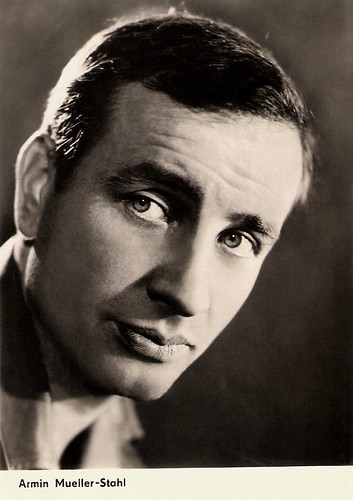
East-German postcard by VEB Progress Film-Vertrieb, Berlin, no. 1910, 1963, Retail price: 0,20 DM. Photo: DEFA / Pathenheimer.
Armin Mueller-Stahl (1930) is a German film actor, painter, writer and musician. He started his career as a socialist matinee-idol in the GDR. At 50, he had to emigrate to West-Germany where he found work with such major film directors as Rainer Werner Fassbinder. Later he had a successful career in Hollywood as well.
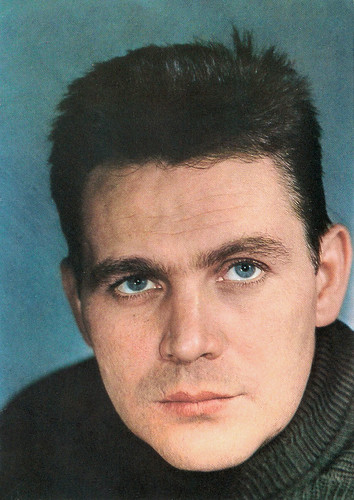
East-German postcard by VEB Progress Film-Vertrieb, no. 2265, 1965. Retail price: 0,15 MDN. Photo: Schwarzer.
German actor, film director and screenwriter Ulrich Thein (1940–1995) appeared in 44 films and television shows between 1952 and 1995. His film Romanze mit Amélie/Romance with Amelie (Ulrich Thein, 1982) was entered into the 32nd Berlin International Film Festival.
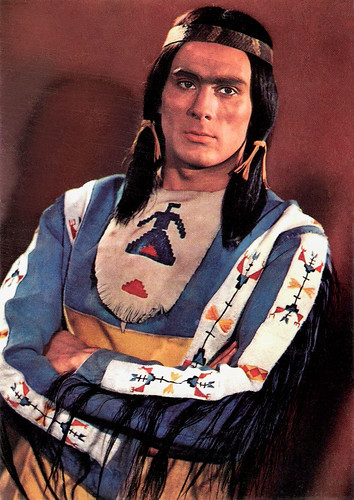
East-German postcard by VEB Progress Film-Vertrieb, Berlin, no. 2401, 1966. Retail price: 0,15 MDN. Photo: Hans-Joachim Kundt. Publicity still for Die Söhne der grossen Bärin/The Sons of Great Bear (Josef Mach, 1966).
Serbian actor Gojko Mitić (1940) was the most famous Indian in Eastern Europe. The handsome star played in numerous Westerns from East-Germany between 1966 and 1984. He also worked as a director, stuntman, and author.
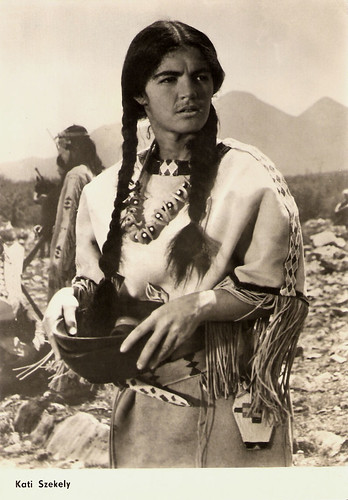
East-German postcard by VEB Progress Film-Vertrieb, Berlin, no. 2.551, 1966. Retail price: 0,20 DM. Photo: Pathenheimer / DEFA. Publicity still for Die Söhne der großen Bärin/The Sons of Great Bear (1965).
Kati Székely (1941) appeared in the first Indians film of the DEFA, Die Söhne der großen Bärin/The Sons of Great Bear (Josef Mach, 1965), based on the novel by Lieselotte Welskopf-Henrich. She played the sister of the young Dakota Indian chief Tokei-ihto (Gojko Mitic). One of her other major films was the first film about the Berlin wall … Und deine Liebe auch/... And your love too (1962, Frank Vogel) with Armin Mueller-Stahl. After marrying Jürgen Frohriep, she gave up acting and studied psychology.
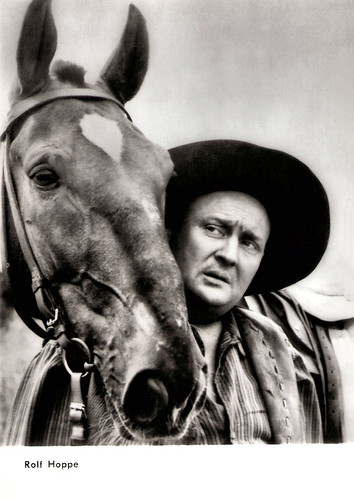
East-German postcard by VEB Progress Film-Vertrieb, Berlin, no. 221/69. Photo: publicity still for Spur des Falken/Trail of the Falcon (Gottfried Kolditz, 1968).
Rolf Hoppe (1930-2018) played villains in many ‘Osterns’ by the DEFA. An example is Spur des Falken/Trail of the Falcon (Gottfried Kolditz, 1968), starring Gojko Mitic as the Indian hero. Hoppe also appeared in other Mitic films, Weiße Wölfe/White Wolves (Konrad Petzold, Bosko Boskovic, 1969), one of the most popular DEFA films ever, and Tödlicher Irrtum/Fatal Error (Konrad Petzold, 1970), also with Armin Müller-Stahl. In 1971, Hoppe was awarded the National Prize of East Germany for artistic achievement.
DEFA is associated with a host of important and influential directors, including Frank Beyer, Wolfgang Staudte, Kurt Maetzig, Konrad Wolf, and Heiner Carow. Yet it was difficult to become a director without following a strictly predefined path which included attending the Babelsberg Film Academy, founded in 1954 as the Deutsche Hochschule für Filmkunst (German Academy for Film).
At the same time, the DEFA managed to get many of the country's major writers involved in film projects: Christa Wolf, Klaus Schlesinger, Fritz Rudolf Fries. Others like Günther Rücker and Jurek Becker worked as freelance or salaried screenwriters. With a large pool of outstanding actors at its disposal (most of them from East Berlin theatres), the DEFA produced first-rate film actors, some of whom – such as Manfred Krug, Armin Mueller-Stahl, Angelica Domröse and Jutta Hoffmann – became stars whose popularity endured even after their defection to the west.
East Germany's most popular star was Erwin Geschonneck. As a communist in Nazi Germany, he was forced to emigrate, only to be extradited to the Nazis by the USSR, after which he survived several years in a concentration camp. After the war he worked with Bertolt Brecht at the Berliner Ensemble. On several occasions he used his influence to lift the prohibition on blacklisted films (his own included).
In the 1980s the GDR opened its film market to western productions, one of the major factors leading to a crisis at the DEFA. Finally, the end came with the fall of the Berlin Wall and the reunification of Germany. In 1992, DEFA was officially dissolved and its combined studios sold to a French conglomerate, Compagnie Générale des Eaux, later Vivendi Universal. On 13 October 1993, the last feature film with the DEFA signet, Novalis - Die blaue Blume/Novalis - the Blue Flower (Herwig Kipping, 1993), celebrated its premiere.
In 2004, a private consortium acquired the studios. The films produced at the DEFA studios after World War II included approximately 950 feature films, 820 animated films, more than 5,800 documentaries and newsreels. Some 4,000 foreign language films were dubbed into German, which were acquired by the privatised version of the former East German film distribution monopoly, Progress Film. The DEFA estate is presently administered by the DEFA Foundation.
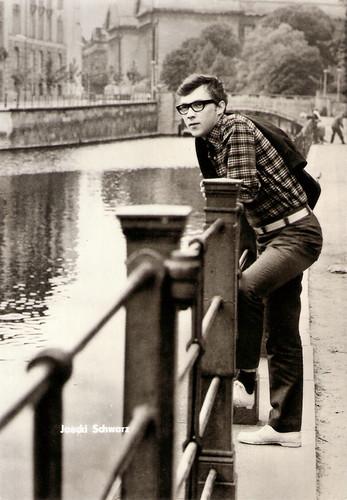
East-German card by VEB Progress Filmvertrieb, Berlin, no. 134/69, 1969. Photo: Uhlenhut.
As a student, Jaecki Schwarz (1946) had his breakthrough with his lead role in the war film Ich war neunzehn/I was nineteen (Konrad Wolf, 1968). With his non-convential acting style and his dry humour, he became a popular actor in dozens of DEFA films and East-German TV productions.
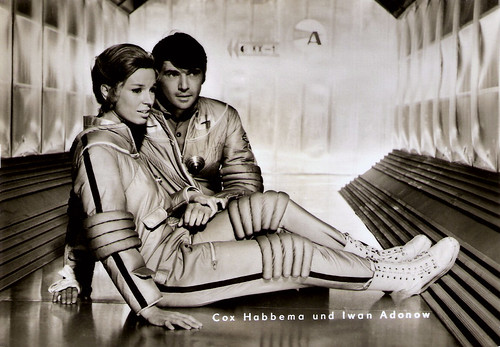
East-German postcard by VEB Progress Film-Vertrieb, Berlin, no. 17/72, 1971. Retail price: 0,20 DM. Photo: DEFA. Publicity still for Eolomea (Herrmann Zschoche, 1971) with Cox Habbema and Ivan Adonov.
Cox Habbema (1944-2016) was a Dutch actress, stage director, writer and former managing director of the Municipal Theatre in Amsterdam. From 1969 till 1984 she mainly lived and worked in East-Berlin, where she appeared in several DEFA films.
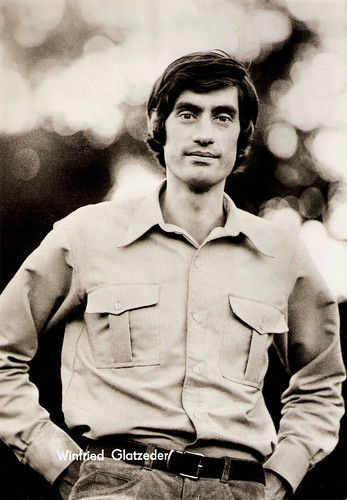
Big East-German postcard by VEB Progress Filmvertrieb, Berlin, no. 163/73, 1971. Retail price: 0,50 M. Photo: Linke.
Tall and lean Winfried Glatzeder (1945) was one of the most popular film stars of former East Germany. He played the charming, gawky Paul in the GDR cult-film Die Legende von Paul und Paula/The Legend of Paul and Paula (Heiner Carow, 1973).
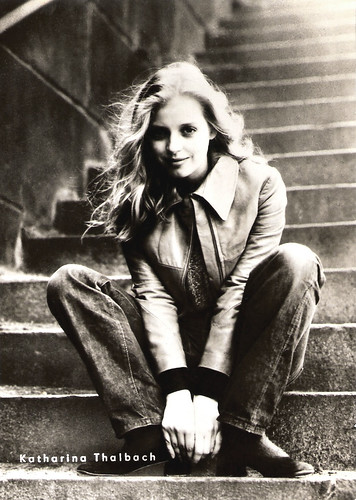
East-German postcard by VEB Progress Film-Vertrieb, Berlin, no. 143/72. Photo: Blasig. Publicity still for Es ist eine alte Geschichte/It Is an Old Story (Lothar Warneke, 1972).
Katharina Thalbach (1954) is one of Germany's most respected stage actresses mostly working in Hamburg and Berlin. With her half-brother Benjamin, she played in the DEFA film Es ist eine alte Geschichte/It is an old story (Lothar Warneke, 1972). In 1975, she appeared in another DEFA production Lotte in Weimar (Egon Günther, 1975), starring Lilli Palmer and based on the novel by Thomas Mann. In December 1976, she left East Germany together with longtime companion Thomas Brasch and daughter Anna after the expulsion of songwriter Wolf Biermann. Internationally, she became known for her part in Die Blechtrommel/The Tin Drum (1979), Volker Schlöndorf’s award-winning film adaptation of the novel by Günter Grass. She has also directed since the late 1980s.
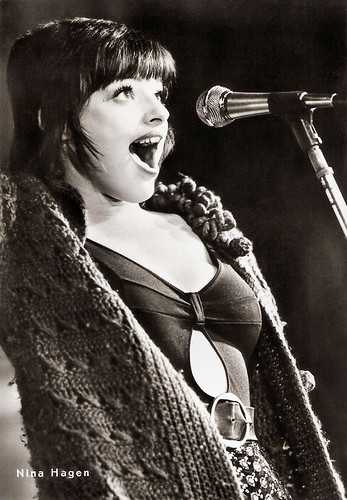
East-German postcard by VEB Progress Film-Verleih, Berlin, no. 147/75. Photo: DEFA.
Nina Hagen (1955) is known for her theatrical vocals and is often referred to as the ‘Godmother of Punk' due to her prominence during the punk and new wave movements in the late 1970s and early 1980s. During her 40-years-career she appeared in several European films, including several East-German films and TV films sometimes alongside her mother Eva-Maria Hagen. She appeared in Heiraten/Weiblich/Marrying/Female (Christa Kulosa, 1975), Heute ist Freitag/Today is Friday (Klaus Gendries, 1975), Liebesfallen/Love Traps (Werner W. Wallroth, 1976) and Unser stiller Mann/Our Quite Man (Bernhard Stephan, 1976). Her career in the GDR was cut short after her stepfather Wolf Biermann's East German citizenship was withdrawn from him in 1976.
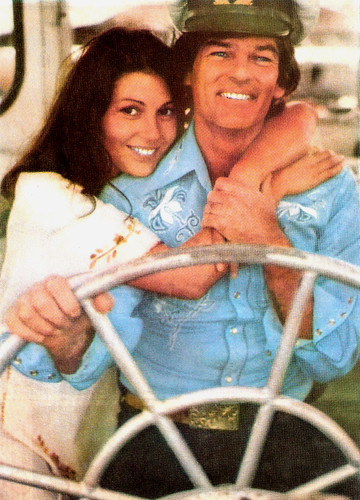
Romanian postcard by Casa Filmului Acin, no. 43080.
American actor, singer and political activist Dean Reed (1938–1986) was one of the most unusual European film stars ever. While he was unknown at home in the US, he was a superstar in communist Eastern Europe. Over the years ‘the Red Elvis’ played in 23 films, including a series of Easterns fro the DEFA. His third wife, German actress Renate Blume (1944) appeared in more than 70 films and television shows since 1964. Her film debut Der geteilte Himmel/Divided Heaven (Konrad Wolf, 1964) was an international success and later she co-starred in Easterns with Gojko Mitic and Dean Reed.
Sources: Hans-Michael Bock (Filmportal.de) and Wikipedia.

East-German postcard by VEB Progress Film-Vertrieb, Berlin, no. 7/319. 1957. Photo: DEFA.
Rebellious, gravel-voiced actress, chanteuse and author Hildegard Knef (1925-2002) was one of the most important film stars of post-war Germany. She had her breakthrough in the first film released after World War II in East Germany, Die Mörder sind unter uns/The Murderers Are Among Us (Wolfgang Staudte, 1946), produced by the DEFA. Her powerful performance as a Holocaust survivor amid the ruins of postwar Berlin made her immediately a star. Over 4 million East-Germans went to the cinema to see it.

German postcard by Starfoto Hasemann. Photo: DEFA. Publicity still for Freies Land/A Free Country (Milo Harbich, 1946).
Fritz Wagner (1915-1982) was a handsome German star in the European cinema of the 1940s and 1950s. From 1938 to 1976, he appeared in more than sixty films and TV productions. After the war, he played a leading role in the drama Freies Land/A Free Country (Milo Harbich, 1946) the second film of the newly founded DEFA studio in the Soviet occupation zone which later became East Germany. The propaganda film portrayed the effects of land reforms brought in by the Soviet authorities. It would be the only DEFA film until the mid-1950s that dealt with the hardships of East-Germany's rural life, and was heavily influenced by the Italian Neorealism of that time. Most people in the film weren't professional actors but farmers. The film proved to be very unsuccessful on its release. For the DEFA, he also played a leading role in the war drama Die Brücke/The Bridge (Arthur Pohl, 1949), and in Der Kahn der fröhlichen Leute/The boat of the happy people (Hans Heinrich, 1950) which sold more than 4,100,000 tickets.

East-German postcard by VEB Progress Filmvertrieb, no. 620/64. Photo: DEFA / Neufeld. Publicity still for Figaros Hochzeit/The Marriage of Figaro (Georg Wildhagen, 1949).
Austrian Angelika Hauff (1922–1983) played the lead in several post-war German and Austrian films. For the DEFA, she appeared in three films, including the box office hit Figaros Hochzeit/The Marriage of Figaro (Georg Wildhagen, 1949) with Willy Domgraf-Fassbaender and Sabine Peters. It was based on the opera 'The Marriage of Figaro' by Wolfgang Amadeus Mozart and Lorenzo da Ponte, which was itself based on the play 'The Marriage of Figaro' by Pierre Beaumarchais. Hauff plays the chambermaid Susanna, around whom the men fight. The film was the first opera film made by DEFA and it was a huge success with 5,479,427 tickets sold.
A primary means of re-educating the German populace
The DEFA was officially founded on 17 May 17, 1946 in the former Althoff Studios in Potsdam-Babelsberg, part of the Soviet Occupied Zone in eastern Germany. It was the first film production company in post-war Germany. While the other Allies, in their zones of occupation, viewed a rapid revival of a German film industry with suspicion, the Soviets valued the medium as a primary means of re-educating the German populace as it emerged from twelve years of Nazi rule. The Soviet Military Administration (SMAD) handed over the license to 'Filmaktiv', a group of committed filmmakers and German Communist Party (KPD) members.
However, Wolfgang Staudte had already begun work on DEFA's first film, Die Mörder sind unter uns/The Murderers Are Among Us (1946) a few days days earlier. The first DEFA production was also Germany's very first post-war film. Staudte's film launched a long-term DEFA policy: in its style, content and ideology, it was a reaction against the propaganda films of Nazi Germany, a tactic which was to be especially successful in the DEFA's early classics. Stylistically, Die Mörder sind unter uns carried on the expressionist lighting tradition of the 1920s.
In Freies Land/Free Land (1946), Milo Harbich tried to synthesise stylistic elements of Soviet revolutionary film with didactic sermons on land reform. Kurt Maetzigs first feature film, Ehe im Schatten/Marriage in the Shadows (Kurt Maetzig, 1947), tells the story of married actors driven to suicide by the Nazis' anti-Semitic persecution, based on the fate of Joachim Gottschalk and his wife. The film was shown in all four occupation zones and drew more than ten million viewers in three years. Wolfgang Staudte's Rotation (1949) took a new approach to early 20th century German history by showing the lives of proletarian families, a contrast to the bourgeois perspective which had hitherto predominated.
The original board of directors consisted of Alfred Lindemann, Karl Hans Bergmann, and Herbert Volkmann, with Hans Klering as administrative Secretary. Klering, a former graphic designer, also designed DEFA's logo. On 13 August 1946, the company was officially registered as a joint-stock company (German: Aktiengesellschaft). By the end of the year, in addition to the Staudte film, it had completed two other feature films using the former Tobis studio facilities in Berlin and the Althoff Studios in Babelsberg. Subsequently, its principal studio was the Babelsberg Studio built by Ufa in the 1920s.
The DEFA was controlled by the Soviets. On 14 July 1947, the company officially moved its headquarters to the Babelsberg Studio, and on 13 November 1947, the company's 'stock' was taken over by the Socialist Unity Party or SED, which had originally capitalised DEFA, and pro-Soviet German individuals. Soviets Ilya Trauberg and Aleksandr Wolkenstein joined Lindemann, Bergmann and Volkmann on the board of directors, and a committee was established under the auspices of the Socialist Unity Party to review projects and screen rushes.
In July 1948, Lindemann was dismissed from the board of directors because of alleged 'financial irregularities' and replaced briefly by Walter Janka. In October 1948, the SED was instrumental in replacing Janka, Volkmann and Bergmann as corporate directors with official party members Wilhelm Meissner, Alexander Lösche and Grete Keilson. In December, the death of Trauberg and the resignation of Wolkenstein resulted in two more Soviets in their stead, Aleksandr Andriyevsky and Leonid Antonov.
In 1948, the division of Germany into zones controlled by the Soviet Union and by the Western Allies came into effect. The SED eventually became openly Communist, with a strong Stalinist orientation. On 23 May 1949, the Allies' Germany officially became the Federal Republic of Germany (commonly known as West Germany), and on 7 October 1949, the Soviet zone officially became the German Democratic Republic (East Germany). All DEFA interests were incorporated into the new nation as its 'people's' film monopoly according to the strictures of Stalinist Communism and socialist realism, and effectively an arm of the government.
In 1949 director Kurt Maetzig and the writer Friedrich Wolf exposed the close connections between the Nazis and the giant chemical company IG Farben in the film Der Rat der Götter/The Council of the Gods (Kurt Maetzig, 1950). Wolfgang Staudte's Der Untertan/Man of Straw (1951) was a scathing satire of German philistinism based on the novel by Heinrich Mann. The film was banned in West Germany for years.
This era at the DEFA came to a close around 1950, when the cultured, more liberal Soviet film officers and inspectors left the country after the founding of the GDR. The DEFA was taken over by German Stalinists like hardliner Sepp Schwab, who was appointed director-general of DEFA on 23 June 1950.

East-German postcard by VEB Progress Film-Vertrieb, no. no. 4213/447, 1957. Photo: DEFA / Wunsch. Publicity still for Das singende, klingende Bäumchen/The Singing Ringing Tree (Francesco Stefani, 1957).
Christel Bodenstein (1938) appeared in many DEFA productions and is best known for her leading role as princess in the fairytale film Das singende, klingende Bäumchen/The Singing Ringing Tree (Francesco Stefani, 1957). The story, written by Anne Geelhaar, was based on a variation of 'Hurleburlebutz' by the Brothers Grimm. Bodenstein played a beautiful but selfish and haughty princess who rejects the proposal of a wealthy prince (Eckart Dux). After its release in East Germany, the film sold almost 6 million tickets in the country of about 17 million.

East-German postcard by VEB Progress Filmvertrieb, no. 966, 1959. Retail price: 0,20 DM. Photo: DEFA / Dassdorf. Publicity still for Reportage 57 (János Veiczi, 1959).
German actor Manfred Krug (1937) was often cast as a socialist hero in DEFA films of the former GDR. He also became known in East-Germany as a jazz singer. In 1977, he returned to West-Germany, where he became a popular TV star.

East-German postcard by VEB Progress Filmvertrieb, Berlin, no. 1329 F, 1960. Photo: Kurt Wunsch.
Doris Abesser (1935–2016) appeared since 1956 in several films by the DEFA and became one of the studio’s most popular stars. She worked with important directors like Frank Beyer, Heiner Carow and Kurt Maetzig. After the film Der Frühling braucht Zeit/Spring Takes Time (Günter Stahnke, 1965) was banned, the promising film career of the fresh and girly actress stalled.

East-German postcard by VEB Progress Film-Vertrieb, Berlin, no. 1649, 1961. Retail price: 0,20 DM. Photo: Schütt / DEFA.
Angelica Domröse (1941) was one of the most famous film and stage actresses of former East Germany. She became a superstar through her role as the young mother Paula in the cult classic Die Legende von Paul und Paula/The Legend of Paul and Paula (Heiner Carow, 1973).

East-German postcard by VEB Progress Filmvertrieb, Berlin, no. 1684, 1962. Photo: Georg Meyer-Hanno.
Gisela May (1924-2016) was the first lady of the political song and a German national treasure. She was famous for her work at Bertolt Brecht's theatre group, the Berliner Ensemble. She was a diseuse (singing actress) in the tradition established by Lotte Lenya and Marlene Dietrich, and expert interpreter of the work of Brecht, Kurt Weill, Hanns Eisler, Kurt Tucholsky, and Jacques Brel. She also appeared in several DEFA productions and a few international films.
The definition of desirable and acceptable themes for films becoming narrower
Hans Michael Bock at Filmportal.de: "The DEFA was based on the kind of traditional studio structure used in the Ufa and in Hollywood of the 1930s, but with one crucial difference: in Hollywood and even in Nazi Germany a number of production companies existed in competition, while in the GDR there was only one, and it was controlled by state and party functionaries, with the Hauptverwaltung Film playing the crucial role from 1954 onward. The official policy was to hire no directors or screenwriters tainted by association with National Socialist propaganda films. However, those who had worked in a 'merely' technical capacity during that period were welcome."
In the tradition of all major studios, the DEFA Studios in Potsdam-Babelsberg (the former 'Ufa city') had professionals in nearly all branches of the film industry on its payroll: screenwriters, directors, scenographers, cameramen, technicians and even an ensemble of actors. The result was a high level of technical expertise, especially in the field of set design, where the old German tradition of masters and apprentices continued to flourish.
On the other hand, artistic freedom and risk-taking was limited. As Soviet-Communist-Stalinist influences took hold at DEFA, the definition of desirable and acceptable themes for films became narrower. In June 1947, a film writer's conference held in Potsdam produced general agreement that the 'new' German cinema would disavow both subjects and stylistic elements reminiscent of those seen on German screens during, and prior to, the Nazi era. By 1949, expectations for scripts were codified around a small number of topics, such as '[re-]distribution of land' or 'the two-year plan'. As in the Soviet Union, the excessive control placed by the state on authors of screenplays, as against other literary works, discouraged many competent writers from contributing to East German film.
In 1951, Das Beil von Wandsbek/The Axe of Wandsbek (Falk Harnack, 1951), based on Arnold Zweig's novel written in exile, was banned . The DEFA production was not released until 1962, heavily edited. Erwin Geschonneck's nuanced portrayal of a butcher who becomes a Nazi executioner was out of step with the official policy of depicting moral issues in black and white. With the ban on Das Beil von Wandsbek, a brief five-year period which had produced several classics of German cinema drew to a close.
Screenwriters could find their efforts rejected for ideological reasons at any stage in script development, if not from the outset. The Cold War only made the Communist leaders tighten their grip on 'their' films. The DEFA's production reached an absolute statistical nadir in 1952 and 1953, with only five films produced in each year. As a result, between 1948 and 1953, when Stalin died, the entire film output for East Germany, excluding newsreels and non-theatrical educational films, amounted to fewer than 50 titles.
The best-known film made in this period was Kurt Maetzig's two-part Thälmann – Sohn seiner Klasse / Führer seiner Klasse/Thälmann – Son of His Class / Leader of His Class (1953-1955) – a propagandistic portrait of the German Communist leader who was active in the 1920s and 1930s.
Early on the DEFA made a policy of presenting the GDR as heir to Germany's best cultural traditions. In this spirit it produced adaptations of familiar fairy tales and filmed German literary classics such as Emilia Galotti (1957), Kabale und Liebe/Intrigue and Love (1959), Die schwarze Galeere/The Black Galley (1962) and Minna von Barnhelm (1962), all by theatre director Martin Hellberg.
The popular fairy-tale films include Paul Verhoeven's Das kalte Herz/Heart of Stone/The Cold Heart (1950), DEFA's first colour film, Wolfgang Staudte's Die Geschichte vom kleinen Muck/The Story of Little Mook (1953) and Das tapfere Schneiderlein/The Brave Little Tailor (Helmut Spieß, 1956). This tradition of fairy-tale and children's films was successfully carried on to the very end of the DEFA.
In the 1960s, DEFA produced the popular Eastern Die Söhne der großen Bärin/The Sons of Great Bear (Josef Mach, 1965), based on the novel by Lieselotte Welskopf-Henrich. It starred Serbian actor Gojko Mitić as the Sioux Tokei-itho. This spawned a number of sequels. The Eastern was the typical Eastern Bloc countries' take on the Western. It was notable for inverting Western cliches by portraying the native Americans as the 'good guys', and the American army as the 'baddies'

East-German postcard by VEB Progress Film-Vertrieb, Berlin, no. 1910, 1963, Retail price: 0,20 DM. Photo: DEFA / Pathenheimer.
Armin Mueller-Stahl (1930) is a German film actor, painter, writer and musician. He started his career as a socialist matinee-idol in the GDR. At 50, he had to emigrate to West-Germany where he found work with such major film directors as Rainer Werner Fassbinder. Later he had a successful career in Hollywood as well.

East-German postcard by VEB Progress Film-Vertrieb, no. 2265, 1965. Retail price: 0,15 MDN. Photo: Schwarzer.
German actor, film director and screenwriter Ulrich Thein (1940–1995) appeared in 44 films and television shows between 1952 and 1995. His film Romanze mit Amélie/Romance with Amelie (Ulrich Thein, 1982) was entered into the 32nd Berlin International Film Festival.

East-German postcard by VEB Progress Film-Vertrieb, Berlin, no. 2401, 1966. Retail price: 0,15 MDN. Photo: Hans-Joachim Kundt. Publicity still for Die Söhne der grossen Bärin/The Sons of Great Bear (Josef Mach, 1966).
Serbian actor Gojko Mitić (1940) was the most famous Indian in Eastern Europe. The handsome star played in numerous Westerns from East-Germany between 1966 and 1984. He also worked as a director, stuntman, and author.

East-German postcard by VEB Progress Film-Vertrieb, Berlin, no. 2.551, 1966. Retail price: 0,20 DM. Photo: Pathenheimer / DEFA. Publicity still for Die Söhne der großen Bärin/The Sons of Great Bear (1965).
Kati Székely (1941) appeared in the first Indians film of the DEFA, Die Söhne der großen Bärin/The Sons of Great Bear (Josef Mach, 1965), based on the novel by Lieselotte Welskopf-Henrich. She played the sister of the young Dakota Indian chief Tokei-ihto (Gojko Mitic). One of her other major films was the first film about the Berlin wall … Und deine Liebe auch/... And your love too (1962, Frank Vogel) with Armin Mueller-Stahl. After marrying Jürgen Frohriep, she gave up acting and studied psychology.

East-German postcard by VEB Progress Film-Vertrieb, Berlin, no. 221/69. Photo: publicity still for Spur des Falken/Trail of the Falcon (Gottfried Kolditz, 1968).
Rolf Hoppe (1930-2018) played villains in many ‘Osterns’ by the DEFA. An example is Spur des Falken/Trail of the Falcon (Gottfried Kolditz, 1968), starring Gojko Mitic as the Indian hero. Hoppe also appeared in other Mitic films, Weiße Wölfe/White Wolves (Konrad Petzold, Bosko Boskovic, 1969), one of the most popular DEFA films ever, and Tödlicher Irrtum/Fatal Error (Konrad Petzold, 1970), also with Armin Müller-Stahl. In 1971, Hoppe was awarded the National Prize of East Germany for artistic achievement.
A large pool of outstanding actors
DEFA is associated with a host of important and influential directors, including Frank Beyer, Wolfgang Staudte, Kurt Maetzig, Konrad Wolf, and Heiner Carow. Yet it was difficult to become a director without following a strictly predefined path which included attending the Babelsberg Film Academy, founded in 1954 as the Deutsche Hochschule für Filmkunst (German Academy for Film).
At the same time, the DEFA managed to get many of the country's major writers involved in film projects: Christa Wolf, Klaus Schlesinger, Fritz Rudolf Fries. Others like Günther Rücker and Jurek Becker worked as freelance or salaried screenwriters. With a large pool of outstanding actors at its disposal (most of them from East Berlin theatres), the DEFA produced first-rate film actors, some of whom – such as Manfred Krug, Armin Mueller-Stahl, Angelica Domröse and Jutta Hoffmann – became stars whose popularity endured even after their defection to the west.
East Germany's most popular star was Erwin Geschonneck. As a communist in Nazi Germany, he was forced to emigrate, only to be extradited to the Nazis by the USSR, after which he survived several years in a concentration camp. After the war he worked with Bertolt Brecht at the Berliner Ensemble. On several occasions he used his influence to lift the prohibition on blacklisted films (his own included).
In the 1980s the GDR opened its film market to western productions, one of the major factors leading to a crisis at the DEFA. Finally, the end came with the fall of the Berlin Wall and the reunification of Germany. In 1992, DEFA was officially dissolved and its combined studios sold to a French conglomerate, Compagnie Générale des Eaux, later Vivendi Universal. On 13 October 1993, the last feature film with the DEFA signet, Novalis - Die blaue Blume/Novalis - the Blue Flower (Herwig Kipping, 1993), celebrated its premiere.
In 2004, a private consortium acquired the studios. The films produced at the DEFA studios after World War II included approximately 950 feature films, 820 animated films, more than 5,800 documentaries and newsreels. Some 4,000 foreign language films were dubbed into German, which were acquired by the privatised version of the former East German film distribution monopoly, Progress Film. The DEFA estate is presently administered by the DEFA Foundation.

East-German card by VEB Progress Filmvertrieb, Berlin, no. 134/69, 1969. Photo: Uhlenhut.
As a student, Jaecki Schwarz (1946) had his breakthrough with his lead role in the war film Ich war neunzehn/I was nineteen (Konrad Wolf, 1968). With his non-convential acting style and his dry humour, he became a popular actor in dozens of DEFA films and East-German TV productions.

East-German postcard by VEB Progress Film-Vertrieb, Berlin, no. 17/72, 1971. Retail price: 0,20 DM. Photo: DEFA. Publicity still for Eolomea (Herrmann Zschoche, 1971) with Cox Habbema and Ivan Adonov.
Cox Habbema (1944-2016) was a Dutch actress, stage director, writer and former managing director of the Municipal Theatre in Amsterdam. From 1969 till 1984 she mainly lived and worked in East-Berlin, where she appeared in several DEFA films.

Big East-German postcard by VEB Progress Filmvertrieb, Berlin, no. 163/73, 1971. Retail price: 0,50 M. Photo: Linke.
Tall and lean Winfried Glatzeder (1945) was one of the most popular film stars of former East Germany. He played the charming, gawky Paul in the GDR cult-film Die Legende von Paul und Paula/The Legend of Paul and Paula (Heiner Carow, 1973).

East-German postcard by VEB Progress Film-Vertrieb, Berlin, no. 143/72. Photo: Blasig. Publicity still for Es ist eine alte Geschichte/It Is an Old Story (Lothar Warneke, 1972).
Katharina Thalbach (1954) is one of Germany's most respected stage actresses mostly working in Hamburg and Berlin. With her half-brother Benjamin, she played in the DEFA film Es ist eine alte Geschichte/It is an old story (Lothar Warneke, 1972). In 1975, she appeared in another DEFA production Lotte in Weimar (Egon Günther, 1975), starring Lilli Palmer and based on the novel by Thomas Mann. In December 1976, she left East Germany together with longtime companion Thomas Brasch and daughter Anna after the expulsion of songwriter Wolf Biermann. Internationally, she became known for her part in Die Blechtrommel/The Tin Drum (1979), Volker Schlöndorf’s award-winning film adaptation of the novel by Günter Grass. She has also directed since the late 1980s.

East-German postcard by VEB Progress Film-Verleih, Berlin, no. 147/75. Photo: DEFA.
Nina Hagen (1955) is known for her theatrical vocals and is often referred to as the ‘Godmother of Punk' due to her prominence during the punk and new wave movements in the late 1970s and early 1980s. During her 40-years-career she appeared in several European films, including several East-German films and TV films sometimes alongside her mother Eva-Maria Hagen. She appeared in Heiraten/Weiblich/Marrying/Female (Christa Kulosa, 1975), Heute ist Freitag/Today is Friday (Klaus Gendries, 1975), Liebesfallen/Love Traps (Werner W. Wallroth, 1976) and Unser stiller Mann/Our Quite Man (Bernhard Stephan, 1976). Her career in the GDR was cut short after her stepfather Wolf Biermann's East German citizenship was withdrawn from him in 1976.

Romanian postcard by Casa Filmului Acin, no. 43080.
American actor, singer and political activist Dean Reed (1938–1986) was one of the most unusual European film stars ever. While he was unknown at home in the US, he was a superstar in communist Eastern Europe. Over the years ‘the Red Elvis’ played in 23 films, including a series of Easterns fro the DEFA. His third wife, German actress Renate Blume (1944) appeared in more than 70 films and television shows since 1964. Her film debut Der geteilte Himmel/Divided Heaven (Konrad Wolf, 1964) was an international success and later she co-starred in Easterns with Gojko Mitic and Dean Reed.
Sources: Hans-Michael Bock (Filmportal.de) and Wikipedia.
No comments:
Post a Comment